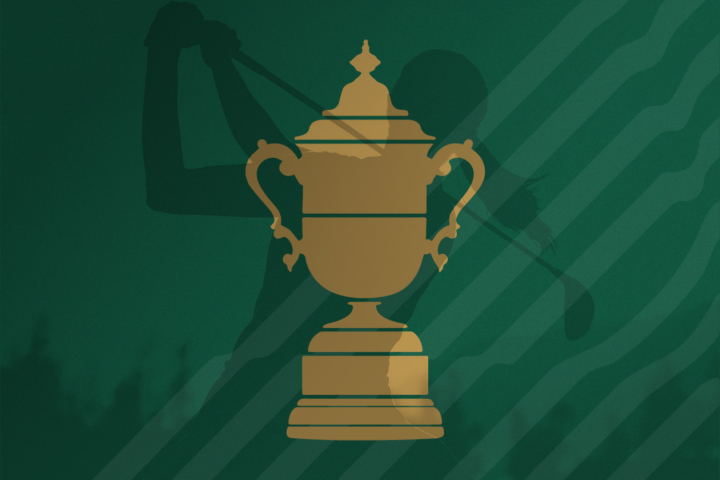Golf is life for Katie Boyce M.A. ’19, but it wasn’t that way until recently.
The William & Mary doctoral candidate works as a historian at the United States Golf Association and is finishing up her dissertation on women’s golf in the Gilded Age called, “Power and Inequality on the Gilded Green: A Tradition Like Every Other.” But not long ago, pitching wedges and putting greens weren’t even remotely part of her expertise.
“I’m a soccer player. I’m a runner. I love basketball. I hadn’t thought much about golf,” she said.
That was before a fellow student at William & Mary suggested golf to her as a fairway to studying sports history in a way that hadn’t been previously explored.
“Since then, I’ve learned we can understand our society so well through golf,” Boyce said. “This is the story I was looking for to study race, class, gender and the environment.”
Aligning with William & Mary’s Vision 2026 mission of educating for impact, Boyce’s research led her to the USGA’s archives and eventually resulted in a job at the governing body’s headquarters in New Jersey.
Her position as historian requires ample research and writing, and it also includes perks like television and podcast appearances.
She recently did a Golf Channel segment on the history of U.S. presidents and golf that aired on President’s Day, and she did an interview on the golf podcast “Talking Golf History” to discuss the history of golf in Los Angeles to preview the 2023 U.S. Open Championship at Los Angeles Country Club.
“I’ve fallen in love with the sport in the process,” said Boyce, who is on track to complete her dissertation in spring of 2024. “Now I play. I didn’t even play before, so it’s really been a great journey, and I feel like it’s just beginning.”

Women’s golf in the Gilded Age
Boyce is studying women golfers in an effort to better understand Gilded Age society. The sport started gaining in popularity during that era in the late 1800s and women golfers received considerable attention during that time.
“We sort of have this assumption that women’s sports didn’t exist so much before Title IX, or if it did it was so below the radar and didn’t get this sort of platform until recently,” Boyce said. “What I’ve learned is that assumption is completely wrong.”
Boyce said she has been “shocked and amazed” by the amount of media coverage women golfers received in the 1890s. They were on the covers of magazines marketed to men, and their tournaments received just as much coverage in newspapers as the men and sometimes more.
“It’s been such a thrill to watch what Katie has accomplished at the USGA in such a short amount of time,” said W&M associate professor Adrienne Petty, Boyce’s doctoral advisor. “She’s using her huge platform at the USGA to show golf enthusiasts, in a fun and accessible way, how the sport impinges on larger developments in United States history.
“People tend to think women did not have a fair shot in competitive sports until the 1970s. Katie’s research will overturn our assumptions by introducing readers to women who were founding figures in the history of golf and who competed with men as equals.”
Boyce is working to explain why the coverage of women’s golf took off at such a high rate during the Gilded Age before falling off so precipitously in the decades to follow.
One possible explanation, Boyce says, is that golf appealed almost exclusively to the affluent during that limited time period, and the women featured on the magazine covers and in newspapers were mainly from wealthy and elite families.
Boyce said golf coverage was comparable to the society pages, but eventually that appeal wore off as golf became more accessible to the rest of the country.
That’s only one of the many stories that have captivated Boyce during her research. Another is the tale of Lucy Barnes Brown. She won the first U.S. Women’s Amateur championship in 1895, but her first name was unknown until 2000. In articles, she was referred to as Mrs. Charles Brown.
“We only knew her husband’s name,” Boyce said. “We didn’t know her name until some of the amazing historians here were able to dig that information up. That just speaks to a lot of the challenges I face in my job every day studying women’s history.
“It’s challenging answering a simple question like, how many times did this woman compete in a USGA championship? She was married three times. She has four different last names, including her maiden name.”
Boyce was also fascinated to learn that the 1896 U.S. Women’s Amateur Championship was played at Morris County Golf Club in New Jersey, a women’s-only course at the time, at the behest of a member of British Parliament named Robert Cox. Furthermore, he donated an ornate championship trophy.
“We still have that 1896 trophy, and it’s gorgeous,” Boyce said. “It’s gilded with jewels and Scottish imagery and images of women playing golf.”
While the popularity of women’s golf waned in the decades following the Gilded Age, it made a major comeback and is now bigger than ever. Household names like Annika Sorenstam and Michelle Wie helped make it more marketable over the last few decades, but Boyce said it has grown even more in the last few years, corresponding with the growing popularity of the WNBA professional basketball league and women’s college basketball, as well.
“We’re seeing an explosion in women’s sports right now. It’s unprecedented,” Boyce said.
The U.S. Women’s Open will be played at Pebble Beach Golf Links from July 5-9 this year for the first time. Pebble Beach has hosted six men’s U.S. Open championships dating back to 1972.
“I think that we’re really showcasing the game at a level that it hasn’t been before,” Boyce said.

‘It’s all right here’
Boyce said she is incredibly thankful for her job as USGA historian and to her William & Mary professors for their flexibility while she balances her work schedule and dissertation.
“It was an amazing opportunity,” she said.
Part of her job now is helping to prepare items and exhibits for the World Golf Hall of Fame, which is relocating from Florida to a new state-of-the-art building in Pinehurst, North Carolina, in 2024.
In writing text for the exhibits, she has been tasked with condensing the careers of Hall of Fame golfers into 100 words.
“I come from an academic background where I’m used to writing a 30-page paper, and now they’re telling me to tell Tiger Woods’ whole story in 100 words,” Boyce laughed.
She has also written some articles about women’s golf, including a piece for New Jersey Golfer Magazine on Mary, Queen of Scots playing golf.
Boyce often walks downstairs from her office to tour the USGA museum archives and look at artifacts. Her favorite items are those that belonged to famous people who weren’t professional golfers, like President Dwight D. Eisenhower’s golf cart or clubs belonging to Jackie Robinson and Amelia Earhart.
“I can go downstairs into our archives and look at something that belonged to President Roosevelt before he contracted polio when he played golf. I can look at Amelia Earhart’s golf clubs. I can look at a Norman Rockwell painting that we have in our fine art collection, and then I can look at Happy Gilmore’s putter from the movie. It’s all right there in this room,” Boyce said.
“How else would you tie together Roosevelt, Earhart, Norman Rockwell and Happy Gilmore? It’s all right here in this museum.”
A few years ago, Boyce didn’t swing a golf club. Now she knows what it feels like to hit a hole in one.
Nathan Warters, Assistant Director of Media Relations

